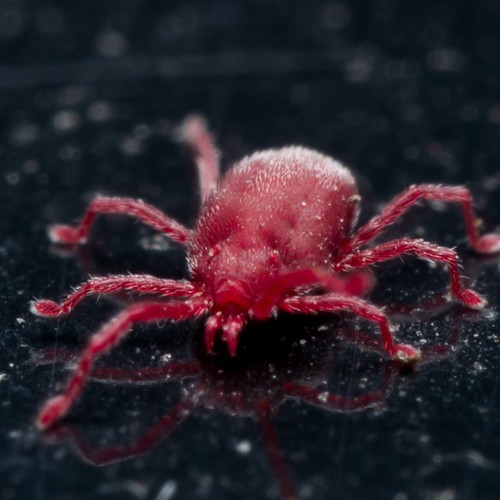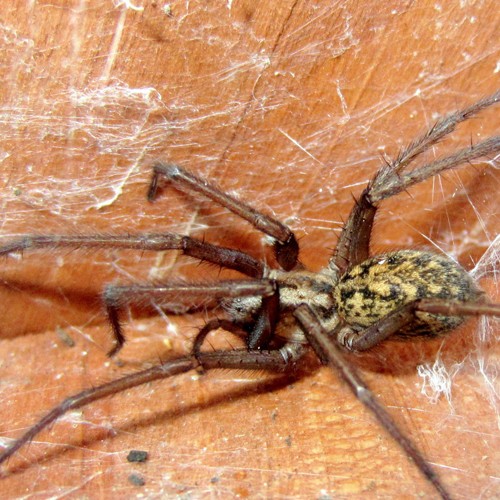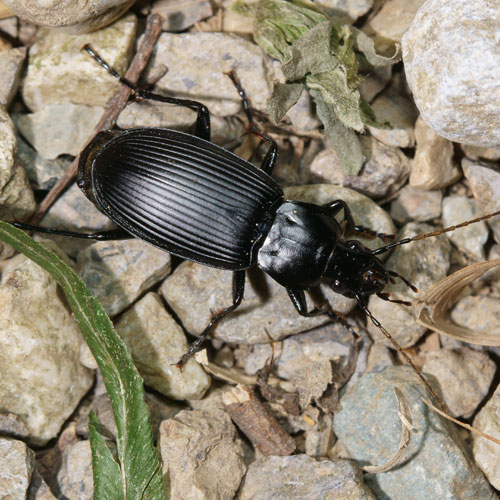Household Pest Control
Boxelder Bugs
Adult boxelder bugs are about 1/2-inch long, black with orange or red color markings, with three stripes on the prothorax, right behind the head. The wings are flat over their long bodies, overlapping each other to form an ‘X’.The nymphs are about 1/16th-inch long and bright red when they hatch. As they grow older and they become larger, they are pretty much just red and black. You can see all stages at any given time during the summertime. Boxelder are for the most part nuisance pests. Boxelder bugs do not cause damage to your home or business, however they’re fecas stain very light surfaces. If you decide to smash the bug, they will emit a unpleasant odor. They are rarely found on male boxelder trees. There is no noticeable feeding injury to these trees. During years of high populations, you may find nymphs on the ground or in gardens feeding throughout the summer. Occasionally some may seek moisture and may be found around houseplants, although they rarely attack them. In the few cases when they do feed, boxelder bugs are unlikely to injure indoor plants. The best management of boxelder bugs is prevention. You can partly do this through exclusion and depends on how your home was constructed.
Stink Bugs
This species will feed on over 300 different kinds of plants, including fruits, vegetables, and row crops. The injury from their piercing-sucking mouth can lead to damage of the crops and severe economic losses.During the winter, they look for shelter, and they find sheltor in houses, garages, or even barns. They can become a nuisance in fall when many bugs can invade a home.True to their name, stink bugs can stink. The smell of them is slightly earthy, some say it resembles cilantro. This defensive liquid is secreted from the underside of their thorax when they feel like they are threatened. They can also spread with the help from humans. They can hitchhike on cars, trucks, campers and suitcases.
Centipede
Centipedes are highly venomous insects and inject paralyzing venom into their prey. They are flattened arthopods with various number of legs from 30 to 354. This is totally contrary to their name 100 legs. They always must have an odd number of legs. They range from sizes from a few centimeters long to almost a foot. Centipedes can also be found in numerous areas in the home, under boards, logs, rocks or any damp location. They tend to migrate in damp areas or in basement of your home. They require a moist environment becasue they lose their own moisture due to their lack of a wax on theeir body. They are different from insects, which have three clear body sections and three pairs of legs because they have numerous body segments and numerous legs. Their bodies are covered with a shell-like covering called an exoskeleton.
Millipede
Millipedes are very similar to centipedes, but they only hae two pairs of legs per their body segment. They are mistakenly refered as “Wireworms” which is a larval stage of beetles. Millipedes have a tendency to live on rotting wood, different types of leaves and decaying moist plant matter. Generally, they play a major beneficial insect because they help break down dead plants, bark and leaves. But at times they have a large population which can damage seedlings, sprouting seeds, or strawberries and other types of fruits that are grown on the ground. Occasionally, large numbers of millipedes migrate due to lack of food supply or their living places become too wet or maybe dry. They occassionally find their way into swimming pools but they drown. To help eliminate them and you can remove rotting wood, grass and leaves from your house’s foundation. You can also eliminate their food sources. To discourage millipedes in garden areas try to reduce the mulch you normally use to avoid excessive moisture.
Fleas
Adult cat fleas of both sexes range up to 1/8″ long and are a reddish-brown color, although the abdomens of females who often swell with eggs making them appear banded in cream and a dark brown. Like all fleas, the cat flea is compressed laterally allowing it to slip between the sometimes dense hairs of its host just above the top layer of the skin, resulting in an extremely thin insect that may be difficult to observe even if the host’s coat is pure white.
The cat flea’s primary host is the domestic cat for which it has a distinct feeding preference, but it is also the primary flea infesting dogs. The cat flea can also maintain its life cycle on other animals, but these are only chosen when more acceptable hosts become unavailable. Adult cat fleas do not willingly leave their hosts, and inter-animal transfer of adult fleas is rare except in animals that share sleeping quarters.
Humans are susceptible to bites from this insect, unless their is a more suitable host (i.e., a cat) is anywhere close by. Research has shown that a female cat flea, can feed undisturbed for 12 consecutive hours on a human, may be capable of producing at least some viable eggs.
German Cockroach
The German cockroach (Blattella germanica) is a species of cockroach, typically about 1/2″ long. In color it varies from tan to black, and it has two dark, roughly parallel streaks on the pronotum running from behind the head to the base of the wings. Although it has wings, it can barely fly, although it may glide when disturbed. Some of the species of cockroach that are domestic pests, it probably is the most widely troublesome example. It is very closely related to the Asian cockroach, and to a observer the two appear nearly identical and may be mistaken for each other. However, the Asian cockroach is attracted to light and can fly rather like a moth, while the German cockroach cannot.
American Cockroach
The American cockroach (Periplaneta americana), also colloquially known as the waterbug, but not a true waterbug since it is not aquatic, or misidentified as the palmetto bug (see Florida woods cockroach for the differences), is the largest species of common cockroach, and often considered a pest. It is also known as the ship cockroach, kakerlac, and Bombay canary. Despite the name, none of the Periplaneta species are endemic to the Americas; P. americana was introduced to the United States from Africa as early as 1625. They are now common in tropical climates because human activity has extended the insect’s range of habitation, and are virtually cosmopolitan in distribution as a result of global commerce.
Silverfish & Firebrats
Silverfish and firebrats are small, carrot shaped insects. They are very similar in appearance, with the major difference being coloration. Silverfish are a grey color while firebrats are a mottled brownish grey. They can be found in stored cardboard boxes, bookshelves, cereals, flour, cotton, linen and woolen clothes. They are attracted to these items for a food source. Protein from glues, starches from sizing in clothing as well as carbohydrates are their preferred food. You will sometimes find them in a sink or tub because they can’t climb out of the slick, curved surface. They thrive in areas with high humidity and temps that range from the upper 70’s to the 90’s and more. They are very fast when you try to catch them. A multi-service agreement is recommended for these infestations. Attic treatment is highly recommended.

Clover Mites
Clover mites are an extremely small yard insect that will invade a living space on occasion. Their actual size is smaller than a pin head. They range in color to an orange to a dark blackish brown. Clover mites are typically seen in large numbers, migrating from the exterior to inside via doorways and windows. They will be on window sills, walls, draperies, etc. They are most active in the spring and fall. You will typically see them on the sunny side of a structure. Vacuum, rather than wiping them up, will avoid the red stain they leave when crushed.

Brown Recluse Spider
The brown recluse, Loxosceles reclusa, Sicariidae (formerly placed in a family “Loxoscelidae”) is a spider with a venomous bite. Brown recluse spiders are usually between 6 and 20 millimetres (0.24 and 0.79 in), but may grow larger. While typically light to medium brown, they range in color from whitish to dark brown or blackish gray. The cephalothorax and abdomen are not necessarily the same color. These spiders usually have markings on the dorsal side of their cephalothorax, with a black line coming from it that looks like a violin with the neck of the violin pointing to the rear of the spider, resulting in the nicknames fiddleback spider, brown fiddler, or violin spider.

Hobo Spider
The hobo spider is a member of the genus of spiders known colloquially as funnel web spiders. The medical significance of its bite is still poorly understood and debated. Individuals construct a funnel-shaped structure of silk sheeting and lie in wait at the small end of the funnel for prey insects to blunder onto their webs.
Hobo spiders sometimes build their webs in or around humans dwellings. The Hobo spider is a resident of fields, rarely entering human habitations due to the presence of major competitors, particularly the giant house spider (Eratigena atrica) which is a common resident of houses and other man-made structures in Europe. As a result, human contacts with the hobo spider are uncommon in Europe.

Wolf Spider
Wolf spiders are members of the family Lycosidae, from the Ancient Greek word “λύκος” meaning “wolf”. They are robust and agile hunters with excellent eyesight. They live mostly solitary and hunt alone. Some are opportunistic hunters pouncing upon prey as they find it or even chasing it over short distances. Some will wait for passing prey in or near the mouth of a burrow.
Wolf spiders resemble Nursery web spiders but wolf spiders carry their egg sacs by attaching them to their spinnerets. Two of the wolf spider’s eight eyes are large and prominent, which distinguishes them from the Nursery web spiders whose eyes are all of approximately equal size. This can also help distinguish them from grass spiders.

Black Widow Spider
Latrodectus is a genus of spider in the big spider family Theridiidae, most of which are commonly known as widow spiders. The genus contains 32 recognized species distributed worldwide, including the North American black widows. The button spiders of Africa, and the Australian redback. Individual species vary widely in size, but in most cases the females are dark-colored and readily identifiable by reddish hourglass-shaped markings on the abdomen.
The venomous bite of these spiders is considered particularly dangerous because of the neurotoxin latrotoxin, which causes the condition latrodectism, both named for the genus. The female black widow has unusually large venom glands and her bite can be particularly harmful to humans. However, despite the genus’ notoriety, Latrodectus bites are rarely fatal.

Cave (Camel) Crickets
Most cave crickets have very large hind legs with “drumstick-shaped” and equally long, thin tibiae, and long, slender antennae. The antennae arise closely and next to each other on the head. They are brownish in color and rather humpbacked in appearance, always wingless, and up to 2″ long in body and 3/8″ for the legs.
Cave crickets are commonly found in caves or old mines. However, species are also known to inhabit other cool, damp environments. Occasionally, they prove to be a nuisance in the basements of homes in suburban areas, drains, sewers, wells and firewood stacks.
Their distinctive limbs and antennae serve a double purpose. They rely heavily on their sense of touch, which is limited by reach. While they have been known to take up residence in the basements. Given their limited vision, cave crickets will often jump towards any perceived threat in an attempt to frighten it away.

Carpenter Ants
Carpenter ants (Camponotus spp.), also known as sugar ants, are large (0.3 to 1.0 in or 0.76 to 2.54 cm) ants indigenous to many forested parts of the world. They build nests inside wood consisting of galleries chewed out with their mandibles, preferably in dead, damp wood. They do not consume the wood, however, unlike termites. Sometimes, carpenter ants hollow out sections of trees. They also commonly infest wooden buildings and structures, and are a widespread nuisance and major cause of structural damage.
One of the most familiar species associated with human habitation in the United States is the black carpenter ant (Camponotus pennsylvanicus). The genus includes over 1,000 species.

Odorous Ants
Tapinoma sessile is a species of ant that goes by the common names odorous house ant, stink ant, and coconut ant. Their colonies are polydomous (consist of multiple nests) and polygynous (contain multiple reproducing queens). Like many social insects, T. sessile employs complex foraging strategies, allocates food depending on environmental conditions, and engages in competition with other insect species. These ants can be found in a huge diversity of habitats, including within houses.
They forage mainly for honeydew, which is produced by aphids and scale insects that are guarded and tended by the ants, as well as floral nectar and other sugary foods. As with most other ants, T. sessile is eusocial. This is characterized by reproductive division of labor, cooperative care of the young, and overlapping generations.

Pavement Ants
The pavement ant, Tetramorium caespitum is an ant native to Europe, but also occurs as an introduced pest in North America. Its common name comes from the fact that colonies in North America usually make their homes in pavement. It is distinguished by one pair of spines on the back, two nodes on the petiole, and grooves on the head and thorax. During early spring, colonies attempt to conquer new areas and often attack nearby enemy colonies.
These result in huge sidewalk battles, sometimes leaving thousands of ants dead. Because of their aggressive nature, they often invade and colonize seemingly impenetrable areas outside their native range. In summer, the ants dig out the sand in between the pavements to vent the nests.

Acrobat Ants
Crematogaster is an ecologically diverse genus of ants found worldwide, which are characterised by a distinctive heart-shaped gaster (abdomen), which gives one of their common names, Valentine ant. Members of this genus are also known as cocktail ants because of their habit of raising their abdomens when alarmed. Most of species are arboreal. These ants are sometimes known as acrobat ants. Acrobat ants acquire food largely through predation of other insects, like wasps.
They use venom to stun their prey and a complex trail-laying process to lead comrades to food sources. Like many social insects, they reproduce in nuptial flights and the queen stores sperm as she starts a new nest.

Ground Beetle
The ground beetle will grow a little over half an inch long. It is nearly all black with some dark reddish-brown coloring on antennae and legs. Many grooves run lengthwise down the beetle’s wings. They live on the ground, on plants, under bark, or as “miners” underground. They prefer to live in moist woods, fields, and gardens. They feed on other insects like caterpillars, aphids and weed seeds. Ground beetles will sometimes climb trees, shrubs, or other plants looking for food but do not fly. The ground beetle is actually important for farmers as a natural pest control insect by control other damaging organisms to the farmer. Ground Beetles breed in late summer. The female lays eggs just below the soil surface. Larvae hatch and spend the winter in the soil. In early spring the larvae begin feeding and then turn into pupae (resting stage). They come out as adult beetles in the summer.

Multi-colored Asian beetle (Lady Bugs)
Lady bugs have oval, dome-shaped bodies with six short legs. There is a wide variety of them, depending on the species. They can have spots, stripes, or no markings at all. Seven-spotted coccinellids are red or orange with three spots on each side and one in the middle; they have a black head with white patches on each side. The bright colors of many coccinellids discourage some potential predators from making a meal along with a bad taste. A further defense, known as “reflex bleeding”, exists in which an alkaloid toxin is exuded through the joints of the exoskeleton, triggered by mechanical stimulation (such as by predator attack) in both larval and adult beetles, deterring feeding. There average life span is up to 2 years. They usually begin to appear indoors in the autumn when they leave their summer feeding sites in fields, forests, and yards and search out places to spend the winter. Typically, when temperatures warm to the mid-60s F in the late afternoon, following a period of cooler weather, they will swarm onto or into buildings illuminated by the sun. They swarm to buildings in September through November depending on location and weather conditions. Homes or other buildings near fields are particularly prone to infestation.




Our Office









